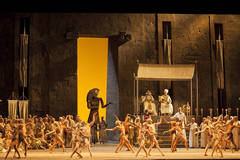| Opera Reviews | 27 April 2024 |
A successful Aida revival in Turinby Silvia Luraghi |
|
Verdi: Aida |
|
|
The imposing sets, with high statues and lofty columns on the sides, hosted a team of singers, acrobats and dancers in Egyptian costumes, looking exactly how one would think they should look at the time in which librettist Antonio Ghislanzoni set the libretto of Giuseppe Verdi’s monumental opera. Dim, bluish lights dominated in the first, third and fourth acts. In the second act, the curtain opened on Amneris’ dressing room, featuring colorful Egyptian paintings on the walls which served as a background for the white costumes of the women. The triumphal scene opened with the Egyptian people gathered to the side and two acrobats descending from high. The King and Amneris reached their thrones while two canoes crossed the stage, followed by the dancers, whose performance, originally directed by choreographer Marc Ribaud and revived by Anna Maria Bruzzese, was really superb, and the dancers received a deserved ovation at the end of the second act. In the final scene, the upper part of the stage rose to show the underground tomb in which Radames and Aida were doomed to die. In the pit, Maestro Gianandrea Noseda gave an unconventional reading of the score, with relatively little emphasis on the monumental side, and greater care for the intimate sections, especially in the third act. The orchestra followed the Maestro with great accuracy and commitment. On stage, the cast was dominated by mezzosoprano Anita Rachvelishvili, an outstanding Amneris, who received ovations both during the performance and at the final curtain. In comparison with her beautifully sounding and perfectly disciplined, sizable mezzo, Kristin Lewis’ soprano, though nicely colored, sounded less secure, and she was often covered by the orchestra, even though the Maestro was certainly not to blame for keeping the volume too high. Also her diction was far from perfect, and her Aida looked more concerned with singing than with her love affair with Radames. The latter was Marco Berti, a veteran of the score and a frequent Radames at the Arena in Verona, due to the huge volume of his ringing tenor, if not to his shading skills. Baritone Mark S. Doss as Amonasro was not especially compelling, while Giacomo Prestia was an imposing Ramfis. The chorus has an important role in Aida, and the Teatro Regio can boast a very skilled team, always willing to act besides singing. The house was full at all performances, and the attentive and delighted audience expressed its appreciation for all aspects of the production.
|
|
| Text ©
Silvia Luraghi Photo © Ramella & Giannese / Teatro Regio Torino |

 As season opener, and on the occasion of the reopening of the Egyptian Museum, Turin’s Teatro Regio revived its William Friedkin 2005 Aida production.
As season opener, and on the occasion of the reopening of the Egyptian Museum, Turin’s Teatro Regio revived its William Friedkin 2005 Aida production.





